Science and Society: Integrating Historical Science Materials Into an Undergraduate Biology Course
Editor: Sue Merkel
Published online:
Abstract
Vision and Change in Undergraduate Biology Education (American Association for the Advancement of Science, 2011) stresses the importance of fostering an understanding of the relationship between science and society. We describe a library-based activity that enables students in an undergraduate microbiology class to explore this relationship over the course of centuries, with the library functioning as a laboratory. Students are guided by a worksheet as they explore historical materials such as books, newspapers, letters, government publications, articles, scientific treatises, and artifacts. Working in pairs, students answer questions about the content and reflect on how the ideas in the documents relate to the scientific understanding at the time. Exploring authentic materials in a library setting provides a powerful learning experience. This activity was also successful using digitized documents during the COVID-19 pandemic, when remote teaching was required. Student responses to a post-activity questionnaire indicated that the activity sparked a keen interest in the history of science as well as introspection about the relationship between science and society. This approach can be generalized for different biology courses and education levels.
Primary image: Students examining historical books and microscopes. Students working in pairs to complete worksheet questions during one of two visits to the University of Colorado Boulder’s Special Collections.
Citation
Copley SD, Babbs S, Losoff B. 2021. Science and society: Integrating historical science materials into an undergraduate biology course. CourseSource. https://doi.org/10.24918/cs.2021.23Lesson Learning Goals
Students will use historical materials to follow the development of thought about microbes and infectious diseases over time. Students will gain a better understanding of how scientific ideas affect the general public and how societal norms affect scientific thinking.Lesson Learning Objectives
After these activities, students will be able to:- discuss examples of historical impacts of infectious diseases on human societies.
- describe examples of technological innovations that enabled leaps in scientific understanding.
- access and handle original historical library materials.
Article Context
Course
Article Type
Course Level
Bloom's Cognitive Level
Vision and Change Core Competencies
Class Type
Class Size
Audience
Lesson Length
Pedagogical Approaches
Principles of How People Learn
Assessment Type
INTRODUCTION
The rapid pace of biological research challenges instructors to present an ever-more sophisticated understanding of biological processes. What is often lost when classes focus on cutting-edge science is exposure to how our current knowledge is built upon the insights of past generations of scientists as well as the societal context of the problems they addressed. Vision and Change in Undergraduate Biology Education (1) emphasizes the importance of understanding the relationship between science and society as a key educational competency. Others have also stressed the value of integrating the social context and the history of biology into science courses (2,3). Studying the history of science allows students to observe how society influences scientific practice and vice versa (4), and to appreciate how the thinking of scientists in the past was both predicated on as well as limited by dominant patterns of thought (e.g., in religion and medicine) and the technological capabilities of the time. Further, exploring the relationship between science and society provides an important foundation for conducting responsible research in the life sciences and for fostering better communication between scientists and the public (5). For example, students may better appreciate the importance of informed consent in biomedical research after researching the history of the infamous Tuskegee syphilis experiment (6,7). Some universities offer entire courses on the history of science and on the relationship between science and society (5,8-10). However, many life sciences students never take such courses. Thus, there is an important place for inclusion of these topics within typical science courses.
Here, we present lessons for two sessions of an undergraduate microbiology course that enable students to explore the history of the discipline and to discover and evaluate ethical concerns, paradigm shifts, and social biases in science. These lessons use primary historical materials (books, pamphlets, articles, diaries, newspapers, magazines, government publications, and artifacts) in a university library collection and/or materials available online. Most of the materials focus on infectious diseases because of the wealth of historical sources available and the intense interest in pathogens and their impact on human societies. The first session follows an introductory lecture on the history of microbiology and allows students to engage with many of the materials mentioned in the lecture. For example, students examine John Snow's 1855 map (Figure 1) showing a cluster of cholera deaths in a neighborhood whose water was supplied from the sewage-contaminated Thames River (8), years before the bacterial cause of the disease was known. Students also evaluate Edward Jenner's earnest, but ethically flawed, efforts to demonstrate the efficacy of inoculation with cowpox for protection against smallpox (11). The second session focuses on specific infectious diseases and precedes a unit that examines molecular and evolutionary aspects of specific bacterial and viral diseases (plague, tuberculosis, influenza and HIV). This session presents a vivid picture of the human cost of infectious diseases and the slowly emerging understanding of their causes and effective treatments. For example, students compare the impact of the 1918 influenza pandemic with the impact of the COVID-19 pandemic on their own lives and consider the biases in the United States Surgeon General's discussion of safe sex during the HIV epidemic. Our implementation of these lessons demonstrates two ways in which instructors can use this approach: to strengthen understanding of material that has already been presented and to spark interest in material that will be presented in future class sessions.
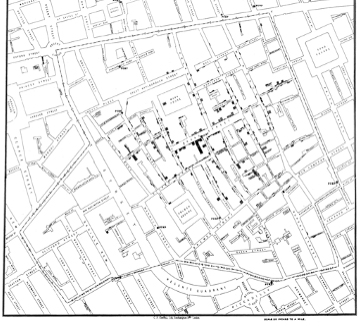
Figure 1. John Snow’s map of cholera cases (black bars) in London in 1854 led him to suspect that contaminated water was spreading the disease (32).
We group historical materials at stations that follow the development of thought about a topic over time or that approach a topic from different points of view. Whenever possible, we include local documents because they provide a particularly accessible connection to the past. In essence, the groupings function as interactive mini-exhibits that place scientific discoveries within the context of society. Some of the documents highlight technological innovations and discoveries that led to paradigm shifts in scientific thinking, such as Antonie van Leeuwenhoek's visualization of swimming microbes that he called "animalcules" (Figure 2, (12)) and Robert Koch's invention of methods for obtaining pure cultures of bacteria, which laid the foundation for Koch's postulates. Others describe desperate attempts by physicians and the public to combat infectious diseases before there was any notion that bacteria and viruses were responsible. The "Receipt against the PLAGUE" (Figure 3) from the Gentlemen's Magazine (13) illustrates an herbal concoction touted as a protection against the plague and presented anecdotal "evidence" for its efficacy.
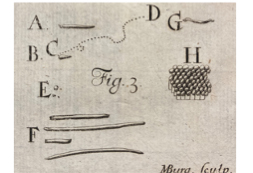
Figure 2. The first drawings of bacteria, from Antonie van Leeuwenhoek’s article in the Philosophical Transactions of the Royal Society in 1684 (12).
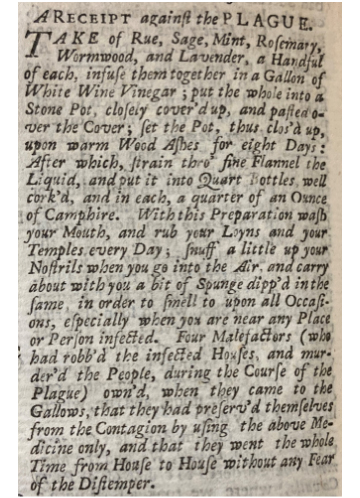
Figure 3. A recipe for a potion against the plague from the 1743 volume of the Gentlemen’s Magazine (13).
Students work in pairs to complete a worksheet that guides them through the material at each station. The worksheets contain three types of questions. Content-related questions require the students to find and interpret specific passages related to the thinking of scientists and the public. Context-related questions explore why people thought about microbiology and infectious disease in the ways that they did and how such opinions affected their daily lives. Higher-level thinking questions ask the students to reflect on trends they discover in materials that span decades or centuries. For example, after examining mortality tables from 1844 and 1942, students consider the kinds of societal changes that might have contributed to changes in mortality patterns.
These lessons have two main goals. First, we aim to introduce students to the social contexts that framed scientific discoveries and the impacts of microbes on the daily lives of the general public. Second, we aim to enable students to trace the development of ideas over decades or centuries. While some materials describe groundbreaking discoveries, others reveal errors stemming from gaps in scientific understanding, making them useful teaching tools (14). As Livio emphasizes, "science is not a direct march to the truth. If not for false starts and blind alleys, scientists would be traveling for too long down too many wrong paths" (15).
Intended Audience
We developed these lessons for an advanced microbiology course. The in-person library experience works well for smaller classes because of the nature of the materials and the library space needed. For larger classes, or when suitable historical materials are not available in a local collection, instructors can create an online version using digitized materials. This approach is easily adapted for both introductory and advanced biology courses with attention to providing students with the necessary background knowledge and asking questions at the appropriate level.
Required Learning Time
The activity consists of two 75-minute sessions, ideally in a library setting. The activity can also be adjusted to fit different time requirements or online/hybrid models.
Prerequisite Student Knowledge
Students should have a basic understanding of bacteria and viruses.
Prerequisite Teacher Knowledge
The instructor should be familiar with key discoveries in the history of microbiology and the pathogens that cause specific infectious diseases. Librarians who assemble the materials and teach the lesson along with the instructor need an intimate knowledge of the science collections at their institution and a basic understanding of microbiology.
SCIENTIFIC TEACHING THEMES
Active Learning
These lessons are motivated by the demonstrated efficacy of active learning in the sciences (21). The tactile and experiential aspects of object-based learning are a powerful way to engage students, facilitate understanding, and enhance memory (22). Such experiences promote curiosity and further learning. For example, Sepel et. al. (23) found that students who used replicas of Leeuwenhoek's microscopes were motivated to explore the internet for more information about the history of microscopy. Even digitized primary materials allow students to read the authentic words of the past and to manipulate the materials by turning pages and zooming in on select passages.
Studying authentic texts from the past can provide what Fink terms a "significant learning experience" (24-26) . Active interaction with historical materials—in contrast to the twentieth-century museum experience of viewing artifacts behind glass walls—produces a vivid and memorable encounter that remains with students long after they complete a class. As an example, a student who took the class five years ago commented recently: "I most remember reading [in the University of Colorado student newspaper] about the 1918 influenza pandemic and the campus closure. Even before our current pandemic situation, that stuck with me... I could put myself in the shoes of the students."
Additionally, this lesson capitalizes on the benefits of collaborative discourse, which improves the depth of student thinking and scientific understanding (19). Students work in pairs during the activity to examine historical materials and to complete worksheet questions. Working together encourages discussion and sharing of opinions about the material. We observed lively discussions both within pairs and between pairs of students who were working at the same station as well as frequent interactions with the instructor and librarians. Instructors can provide an opportunity for broader discussion among the students in a separate class session.
Assessment
Our student assessment consisted of informal classroom observations, answers to worksheet questions, and qualitative feedback from a post-session questionnaire (see "Teaching Discussion" section).
Inclusive Teaching
This active and collaborative exercise encourages discussion among students with different backgrounds, perspectives, and learning strengths. The historical materials highlight various viewpoints on science and infectious diseases: the opinions of scientists, the perceptions of the public, and official government statements and policies. Further, we selected documents that show how social biases have influenced the treatment of marginalized groups in the context of infectious diseases. For example, students examined questionnaires used by the Committee on Indigent Migratory Consumptives from California (1916-1919) to ask business owners about whether they would hire migrants with tuberculosis. Other materials included early perspectives on the HIV pandemic from stigmatized LGBTQ individuals. Such documents offer students a lens to compare the treatment of particular groups of people suffering from health issues in the past and in the present.
LESSON PLAN
Table 1 describes the preparation and implementation of the two library sessions.
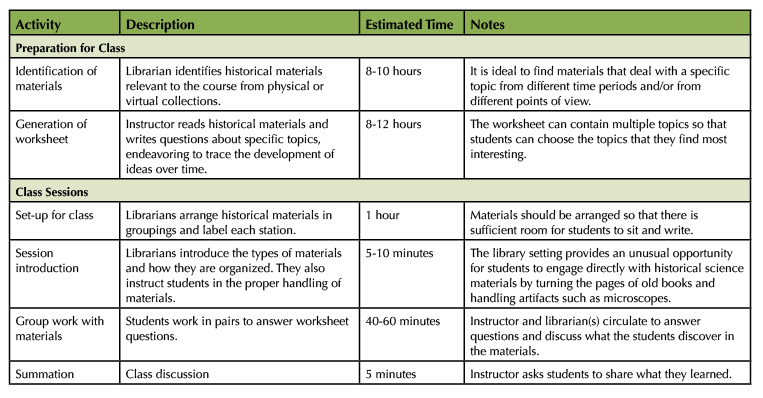
Table 1. Recommended timeline for the Science and Society activity.
Preparation for the Class
The instructor worked with university librarians to identify materials relevant to the course. The instructor and librarians endeavored to select materials from different periods in time, different geographic regions, and different perspectives (e.g., scientists versus the public). The instructor wrote questions about specific passages in the historical materials that illustrate the thinking of scientists and the public.
On the day of the class, librarians set up the materials at clearly labeled stations consisting of related items. The documents at each station were arranged in chronological order so that the students could trace the development of thought about the topic over time. Librarians provided a short written description of each item. Older books were placed in cradles to protect the bindings. Gloves were provided to protect modern photo books with glossy pages, but were not required for older materials. It is important to include a sufficient number of stations in order to prevent overcrowding and to provide enough space at each station for students to sit and write.
Library Sessions
At the beginning of each library session, the instructor outlined the goals of the visit. Librarians introduced the materials and provided an overview on proper handling techniques, such as keeping books in wooden cradles to protect their bindings.
The students then chose a partner to work with, most often the nearest person. Working in pairs fosters discussion and facilitates completion of the worksheet; one student can read passages from a document aloud while the other writes down responses. An instructor could choose to assign students to heterogeneous groups, a practice that has been shown to lead to better problem solving (27) and modestly better learning outcomes for low-competence students when grouped with higher-competence students (28). However, few biology students have substantial historical knowledge that would be helpful to other students, so forming groups based upon competence level is less applicable than it might be for typical group activities in science courses. In addition, the extent of group heterogeneity for this activity is constrained by the group size, which is ideally limited to two so that students can optimally interact with historical documents at the same time.
Table 2 lists the stations for the two library sessions. Librarians circulated through the room during the class period to answer questions and provide extra context. The course instructor provided answers to scientific questions and helped connect the historical material to concepts the students were learning about in the course.
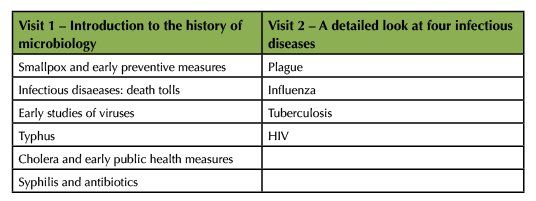
Table 2. Stations for our library sessions.
Examples of historical materials and worksheet questions are provided in Supporting File S1. Science and Society – Examples of historical documents, worksheet questions, and student answers. The complete worksheets for both learning modules are provided in Supporting File S2. Science and Society – Worksheets for two visits to Special Collections. A bibliography of all materials used in the learning modules is provided in Supporting File S3. Science and Society – Bibliography of historical materials. An online version of the second session that was used during the COVID-19 pandemic can be found at the University of Colorado Boulder Libraries Libguide for the course.
TEACHING DISCUSSION
Biology instructors sometimes incorporate historical information into their lectures by describing landmark experiments such as Koch's isolation of anthrax bacilli from infected animals that laid the foundation for the Germ Theory of Disease (29) or the classic experiments of Meselson and Stahl (30) that established that DNA is replicated semi-conservatively, with each strand serving as the template for synthesis of a new strand. With such examples, instructors can convey not only the careful design of experiments that led to leaps in scientific understanding, but also the difficulties early researchers faced given the scientific foundation and technology of the time.
Connecting science to its societal context is also a powerful way to engage student interest. Seemingly esoteric topics become more salient when instructors point out their connections to the daily lives of students and the world in which they live. For example, lectures on the immune system can lead into discussions about the anti-vaccination movement, which has its roots in public anxiety over the use of cowpox to provide protection against smallpox (Figure 4). Lectures on evolution can explore why Darwin's ideas were so antithetical to the religion-dominated society in which he lived. In addition to stimulating student interest, addressing debates over vaccination, climate change, evolution, stem cell research, and alternative medicine (among other topics) prepares students for informed and respectful discussions with non-scientists. The connection between science and society can be addressed using active learning strategies. Contemporary newspaper articles, television shows (10), and internet resources provide a rich source of material for group discussions of the level of understanding—and misunderstanding—of science among the public. A particularly creative approach described by Fink enlisted students in an advanced course to play the roles of real people with diverse opinions on human cloning and stem cell research for students in an introductory biology course (31).
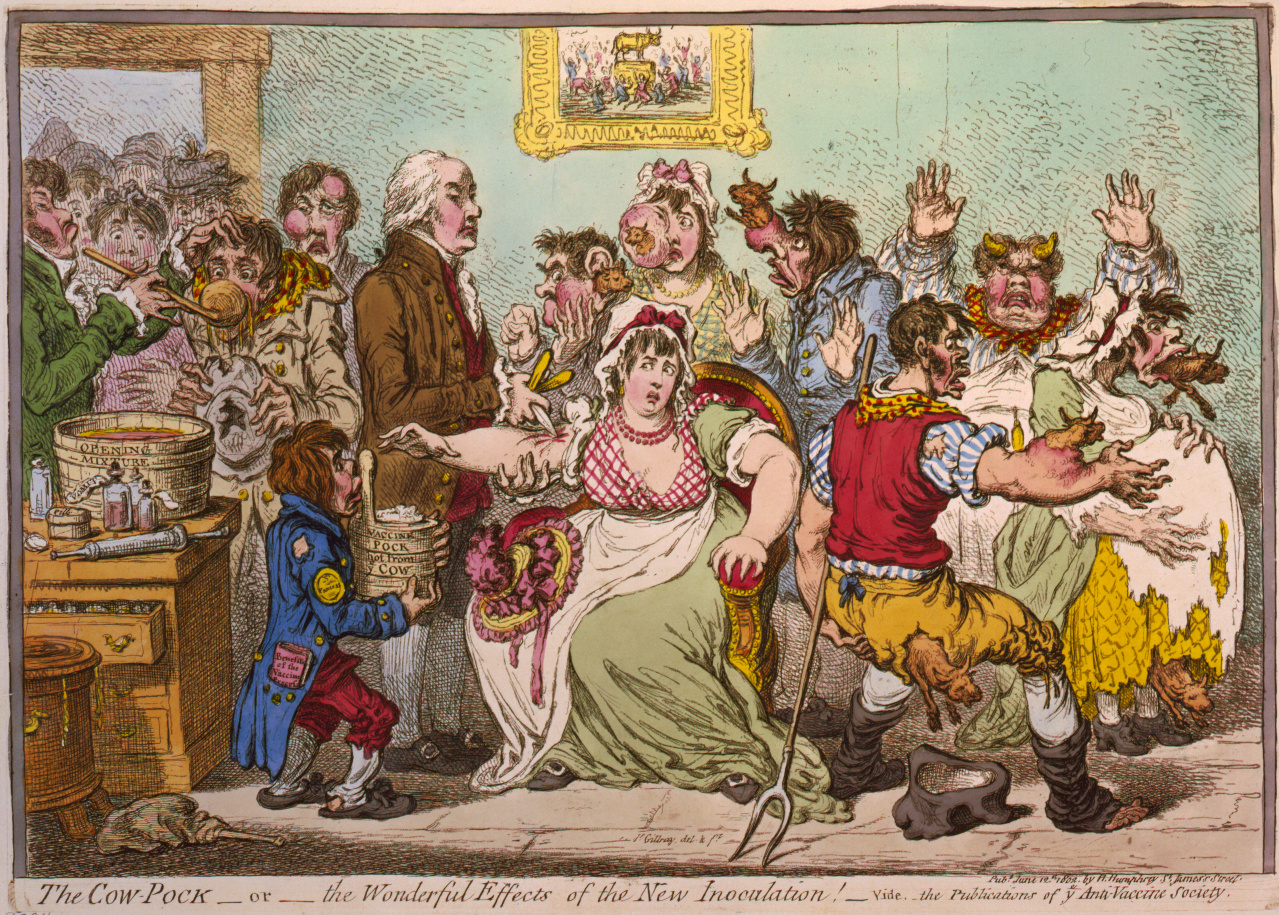
Figure 4. "The Cow-Pock or the wonderful effects of the new inoculation". This 1802 cartoon by the British satirist James Gillray implied that vaccination for smallpox with cowpox caused people to sprout cow parts from their bodies. Reproduced from Wikipedia Commons.
Our approach to increasing student awareness of the societal context of biology is unique because we capitalize on the vivid learning experience generated by object-based learning with historical materials. Students are awestruck by the opportunity to turn the pages of centuries-old books. Further, we integrate the historical and societal contexts using materials that reveal both scientific and public perspectives. Reading the words of scientists and the public in the actual document is more impactful than a description in a lecture. Examining Edward Jenner's descriptions of infecting patients with smallpox to test the efficacy of prior vaccination with cowpox conveys both a sense of how desperate people were to avoid a deadly disease whose viral cause was not understood and an appreciation for modern standards for medical research. These ideas resonate with students who are living through a pandemic caused by a novel infectious agent. Reading poignant accounts of the ostracism of gay men during the early days of the AIDS epidemic shows how the intertwining of moral and religious attitudes with inadequate scientific understanding set the stage for discrimination and misguided policy. Viewing this situation through the lens of history allows students to better appreciate how skepticism and misunderstanding about science leads to polarization of views and unfortunate policy decisions in the current day.
Students in the 2020 class were uniformly enthusiastic about the learning modules, even though they had to complete one module remotely using digitized materials due to the COVID-19 pandemic. Their responses to the questions we asked (Box 1) were detailed and insightful, reflecting deep thinking about their experiences with the historical materials and how what they learned relates to the relationship between science and society in the present (see Supporting File S4. Science and Society – Student responses to assessment questions).
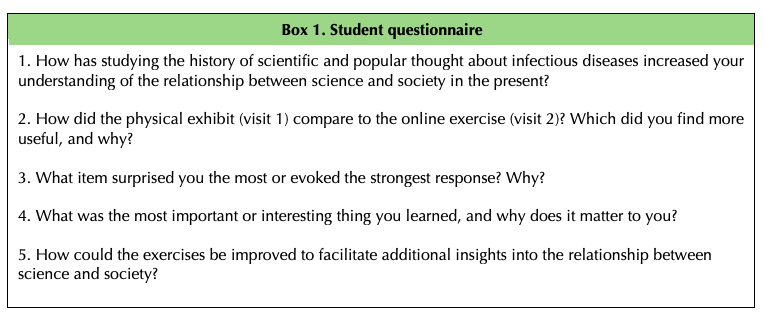
Box 1. Student questionnaire
Student responses indicated an understanding that biological knowledge is a product of human activity, with each researcher building on the work of others (3). Five of 13 students commented explicitly on the development of ideas they saw in the materials. Students commented that the modules provided a "better understanding of the timeline and the progression of science" and that "we are where we are now because of the efforts of society back then." One student noted: "I think it has been important to incorporate history lessons into the semester because, like with most fields that move at a rapid pace, most, if not all, the time is spent covering current topics and technologies. Looking back at history puts some of that technology, for example, microscopy and modern medicine, into perspective."
Recognizing that scientific progress is built on both success and failure (2,15) is an important lesson that emerges from the insights and misconceptions of scientists and physicians of the past. One student wrote that while "we might get quite a bit of it wrong along the way, we'll continue to find solutions and deepen our understanding." Others observed that the evolution of scientific thinking over time suggests that maintaining a sense of humility about current understanding is important. For example, one noted the "shocking confidence" with which medicinal recipes (that we now recognize are ineffective or even toxic) were prescribed. Interestingly, two students mentioned that reading about misguided or erroneous ideas in the past made them less confident in our current understanding.
The learning modules were effective in communicating the relationship between science and society. Students commented on how, in the face of a potentially lethal disease and with little understanding of the relevant science, the public was willing to accept misguided and often preposterous strategies for prevention and treatment. One student was "surprised by the influence of religion, and how the contemporary thought of the time played into the diagnosis and explanation of disease." Some responses addressed how a lack of scientific knowledge can lead to stigmatization of certain populations, a common response to the threat of infectious diseases such as plague, tuberculosis, and HIV/AIDS. One student was unaware of "the extent to which people went to exclude HIV-positive people" early in the AIDS/HIV epidemic and noted that reading a personal account of this prejudice "hurt and broke my heart."
Students remarked on the importance of communication between scientists and the public. One student commented that the experience "reinforced my idea that science should be public knowledge and not something only understood by a few people." Another opined that scientists should demonstrate "best practices with regards to research transparency, data availability, and responsible scientific dialogue" in order to gain public trust. Interestingly, several students recognized that, to some degree, public skepticism about science is based upon past experiences in which scientists promoted treatments and cures before they had adequate knowledge. One student noted "with that in mind, it is a bit more understandable why some people do not trust current scientific studies and claims."
Students acknowledged benefits for both the in-person and virtual learning modules. Most (10 of 13) preferred the in-person experience, citing its "impact," "novelty," and "awe." However, three students preferred the virtual experience because they had more time to explore the materials. One student wrote that "doing the exercise online allowed me to work at my own pace, enjoy the exhibits more in depth, and explore [the exhibits] beyond what was asked of me." Another mentioned: "I spent much more time with the documents during the online exercise, which served to help me connect with the documents and time-period more, despite their being digitized. I read more than was assigned during the digital visit out of pure interest..." One difficulty that students encountered with the virtual exercise was that digital images of very old materials are sometimes difficult to read. In the future, we plan to offer a hybrid experience, with an initial visit to the library to work with the physical materials, followed by additional time to work with the digitized materials.
These lessons clearly succeeded in sparking interest in the relationship between science and society. Students pointed to several different documents that they found particularly intriguing. The 1842 London mortality scroll, contemporary documents about the plague and the 1918 influenza pandemic, and more recent documents about HIV/AIDS were frequently mentioned. Six of 13 students expressed interest in exploring more background materials and additional documents written by non-scientists. To foster further exploration, we have developed a Supplemental Reading List (Supporting File S5. Science and Society – Supplemental Reading List) to be shared with next year's class.
Generalization to Other Courses
The central tenet of this lesson—that historical sources from a library can illuminate the development of scientific ideas and the relationship between science and society—is applicable to a variety of courses, including evolutionary biology, genetics, anatomy, neuroscience, and chemistry. We took advantage of the extensive collection of historical materials available in our university library for the lesson described here. Public libraries, historical societies, and museums may also have relevant materials. Chamany et al. (3) provide an extensive list of resources for teaching the history and societal context of science. The lesson can also be taught effectively using digitized materials. Digitized primary sources are becoming increasingly common as cultural heritage institutions work to make their resources available to wider audiences. Digital materials at sites such as HathiTrust, the Internet Archive, Google Books, the Biodiversity Heritage Library, and the United States National Library of Medicine can supplement the virtual holdings of local libraries. Additionally, collections of historical newspapers such as Chronicling America and local repositories such as Colorado Historic Newspapers are valuable resources. Useful online resources are listed in Supporting File S6. Science and Society – Online resources.
SUPPORTING MATERIALS
- Supporting File S1. Science and Society – Examples of historical documents, worksheet questions, and student answers.
- Supporting File S2. Science and Society – Worksheets for two visits to Special Collections.
- Supporting File S3. Science and Society – Bibliography of historical materials.
- Supporting File S4. Science and Society – Student responses to assessment questions.
- Supporting File S5. Science and Society – Supplemental reading list.
- Supporting File S6. Science and Society – List of digital resources.
ACKNOWLEDGMENTS
The authors would like to acknowledge Deborah Hollis for her inspiration to use rare and historic primary materials for enhancing student learning in the sciences.
References
- American Association for the Advancement of Science. Vision and change in undergraduate biology education: A call to action, Final report. https://visionandchange.org/finalreport.
- Maienschein J. 2000. Why study history for science? Biol Philos 15(3):339-348. doi 10.1023/A:1006733114136.
- Chamany K, Allen D, Tanner K. 2008. Making biology learning relevant to students: integrating people, history, and context into college biology teaching. CBE Life Sci Educ 7(3):267-78. doi 10.1187/cbe.08-06-0029.
- Allchin D, Andersen HM, Nielsen K. 2014. Complementary approaches to teaching nature of science: Integrating student inquiry, historical cases, and contemporary cases in classroom practice. Sci Edu 98(3):461-486. doi 10.1002/sce.21111.
- Almeida MS, Quintanilha A. 2017. Of responsible research-Exploring the science-society dialogue in undergraduate training within the life sciences. Biochem Mol Biol Educ 45(1):46-52. doi 10.1002/bmb.20988.
- Miranda D, Jr., Sanchez DJ. 2014. The Tuskegee experiment: an introduction in ethics for pre-healthcare professional students. J Microbiol Biol Educ 15(2):232-4. doi 10.1128/jmbe.v15i2.781.
- Fourtner A, Charles CR, Herreid CF. 1994. Bad blood: A case study of the Tuskegee Syphilis Project, on National Center for Case Study Teaching in Science. https://sciencecases.lib.buffalo.edu/cs/files/2-bad_blood.pdf.
- Caspers ML, Roberts-Kirchhoff ES. 2003. Incorporation of ethical and societal issues in biochemistry into a senior seminar course. Biochem Mol Biol Ed 31:298-302. doi 10.1002/bmb.2003.494031050258.
- Pierret C, Friedrichsen P. 2009. Stem cells and society: an undergraduate course exploring the intersections among science, religion, and law. CBE Life Sci Educ 8(1):79-87. doi 10.1187/cbe.08-09-0053.
- Vandegrift EVH, Cavanagh AJ. 2019. Building student literacy and metacognition through reading science in the news. CourseSource. https://doi.org/10.24918/cs.2019.37. Accessed
- Jenner E. 1798. An inquiry into the causes and effects of the Variolae vaccinae. printed by the author by Sampson Low, London.
- Leewenhoeck A. 1684. An Abstract of a Letter from Mr. Anthony Leewenhoeck at Delft, dated Sep. 17. 1683. containing some microscopical observations, about animals in the scurf of the teeth, the substance call'd worms in the nose, the cuticula consisting of scales. Phil Trans 14:568-574. doi
- Anonymous. 1743. A receipt against the PLAGUE, vol 13. Edward Cave, London.
- Allchin D. 2012. Teaching the nature of science through scientific errors. Sci Edu 96(5):906-926. doi 10.1002/sce.21019.
- Livio M. 2013. Brilliant blunders: From Darwin to Einstein - Colossal mistakes by great scientists that changed our understanding of life and the universe. Simon and Schuster, New York.
- Bonwell CC, Eison JA. 1991. Active learning: Creating excitement in the classroom. https://eric.ed.gov/?id=ED340272.
- Freeman S, O'Connor E, Parks JW, Cunningham M, Hurley D, Haak D, Dirks C, Wenderoth MP. 2007. Prescribed active learning increases performance in introductory biology. CBE Life Sci Educ 6(2):132-9. doi 10.1187/cbe.06-09-0194.
- Armbruster P, Patel M, Johnson E, Weiss M. 2009. Active learning and student-centered pedagogy improve student attitudes and performance in introductory biology. CBE Life Sci Educ 8(3):203-13. doi 10.1187/cbe.09-03-0025.
- Osborne J. 2010. Arguing to learn in science: the role of collaborative, critical discourse. Science 328(5977):463-6. doi 10.1126/science.1183944.
- Wieman CE. 2014. Large-scale comparison of science teaching methods sends clear message. Proc Natl Acad Sci U S A 111(23):8319-20. doi 10.1073/pnas.1407304111.
- Barlow A. 2016. Beyond object lessons: object-based learning in the academic library, p 27-42. In McDonnell P (ed), The experiential library: transforming academic and research libraries through the power of experiential learning Elsevier.
- Chatterjee HJ, Hannan L. 2016. Engaging the senses: Object-based learning in higher education. Routledge.
- Sepel LM, Loreto EL, Rocha JB. 2009. Using a replica of Leeuwenhoek's microscope to teach the history of science and to motivate students to discover the vision and the contributions of the first microscopists. CBE Life Sci Educ 8(4):338-43. doi 10.1187/cbe.08-12-0070.
- Fink LD. 2003. Creating significant learning experiences: An integrated approach to designing college courses. John Wiley & Sons, Inc. Jossey-Bass, San Francisco.
- Levine LE, Fallahi CR, Nicoll-Senft JM, Tessier JT, Watson CL, Wood RM. 2008. Creating significant learning experiences across disciplines. Coll Teach 56(4). doi 10.3200/CTCH.56.4.247-254.
- Bahde A, Smedberg H, Taormina M. 2014. Using primary sources: Hands-on instructional exercises. ABC-CLIO Libraries Unlimited., Santa Barbara.
- Heller P, Hollabaugh M. 1992. Teaching problem solving through cooperative grouping. Part 2: Designing problems and structuring groups. Am J Physics 60:637-644. doi 10.1119/1.17118
- Donovan DA, Connell GL, Grunspan DZ. 2018. Student learning outcomes and attitudes using three methods of group formation in a nonmajors biology class. CBE Life Sci Educ 17(4):ar60. doi 10.1187/cbe.17-12-0283.
- Brock T. 1988. Robert Koch. A life in medicine and bacteriology doi:10.1016/S0932-4739(89)80082-3. Science Tech Publishing, Madison, WI and Springer-Verlag, Berlin.
- Meselson M, Stahl FW. 1958. The replication of DNA in Escherichia coli. Proc Natl Acad Sci U S A 44(7):671-82. doi 10.1073/pnas.44.7.671.
- Fink RD. 2002. Cloning, stem cells, and the current national debate: incorporating ethics into a large introductory biology course. Cell Biol Educ 1(4):132-44. doi 10.1187/cbe.02-07-0023.
- Snow J. 1855. On the mode of communication of cholera. John Churchill, London.
Article Files
Login to access supporting documents
Science and Society: Integrating Historical Science Materials Into an Undergraduate Biology Course(PDF | 1 MB)
S1.Science and Society-Examples of historical documents worksheet questions and student answers.docx(DOCX | 11 MB)
S2.Science and Society-Worksheets for two visits to Special Collections.docx(DOCX | 39 KB)
S3.Science and Society-Bibliography of Historical Sources.docx(DOCX | 22 KB)
S4.Science and Society-Student responses to assessment questions.docx(DOCX | 26 KB)
S5.Science and Society-Supplemental Reading List.docx(DOCX | 15 KB)
S6.Science and Society-List of Digital Resources.docx(DOCX | 19 KB)
- License terms

Comments
Comments
There are no comments on this resource.